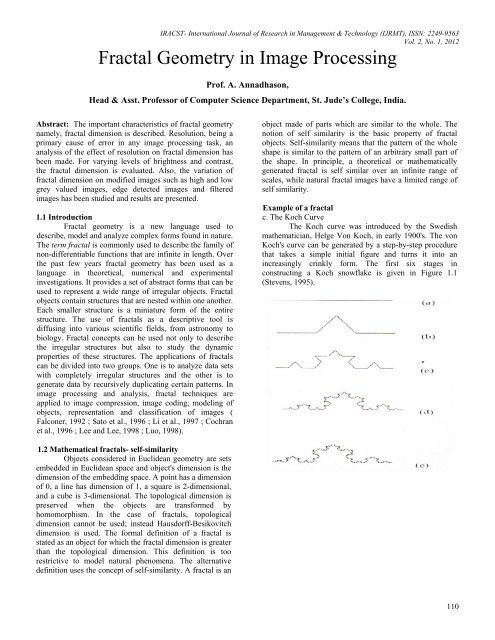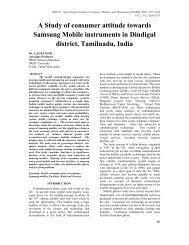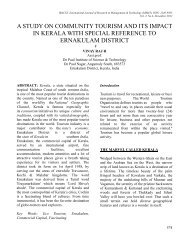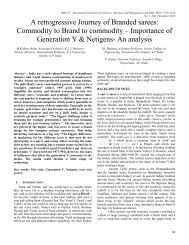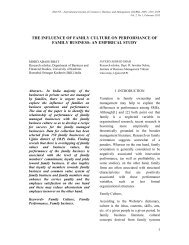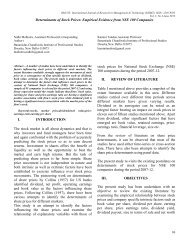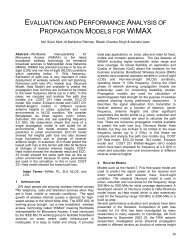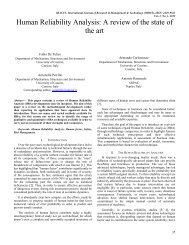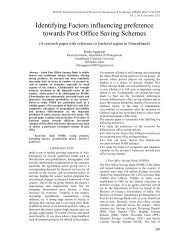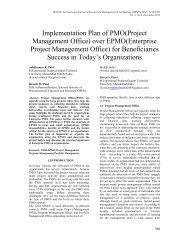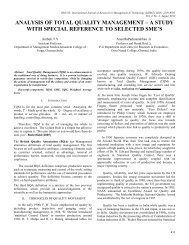Fractal Geometry in Image Processing
Fractal Geometry in Image Processing
Fractal Geometry in Image Processing
You also want an ePaper? Increase the reach of your titles
YUMPU automatically turns print PDFs into web optimized ePapers that Google loves.
IRACST- International Journal of Research <strong>in</strong> Management & Technology (IJRMT), ISSN: 2249-9563<br />
Vol. 2, No. 1, 2012<br />
<strong>Fractal</strong> <strong>Geometry</strong> <strong>in</strong> <strong>Image</strong> Process<strong>in</strong>g<br />
Prof. A. Annadhason,<br />
Head & Asst. Professor of Computer Science Department, St. Jude’s College, India.<br />
Abstract: The important characteristics of fractal geometry<br />
namely, fractal dimension is described. Resolution, be<strong>in</strong>g a<br />
primary cause of error <strong>in</strong> any image process<strong>in</strong>g task, an<br />
analysis of the effect of resolution on fractal dimension has<br />
been made. For vary<strong>in</strong>g levels of brightness and contrast,<br />
the fractal dimension is evaluated. Also, the variation of<br />
fractal dimension on modified images such as high and low<br />
grey valued images, edge detected images and filtered<br />
images has been studied and results are presented.<br />
1.1 Introduction<br />
<strong>Fractal</strong> geometry is a new language used to<br />
describe, model and analyze complex forms found <strong>in</strong> nature.<br />
The term fractal is commonly used to describe the family of<br />
non-differentiable functions that are <strong>in</strong>f<strong>in</strong>ite <strong>in</strong> length. Over<br />
the past few years fractal geometry has been used as a<br />
language <strong>in</strong> theoretical, numerical and experimental<br />
<strong>in</strong>vestigations. It provides a set of abstract forms that can be<br />
used to represent a wide range of irregular objects. <strong>Fractal</strong><br />
objects conta<strong>in</strong> structures that are nested with<strong>in</strong> one another.<br />
Each smaller structure is a m<strong>in</strong>iature form of the entire<br />
structure. The use of fractals as a descriptive tool is<br />
diffus<strong>in</strong>g <strong>in</strong>to various scientific fields, from astronomy to<br />
biology. <strong>Fractal</strong> concepts can be used not only to describe<br />
the irregular structures but also to study the dynamic<br />
properties of these structures. The applications of fractals<br />
can be divided <strong>in</strong>to two groups. One is to analyze data sets<br />
with completely irregular structures and the other is to<br />
generate data by recursively duplicat<strong>in</strong>g certa<strong>in</strong> patterns. In<br />
image process<strong>in</strong>g and analysis, fractal techniques are<br />
applied to image compression, image cod<strong>in</strong>g, model<strong>in</strong>g of<br />
objects, representation and classification of images (<br />
Falconer, 1992 ; Sato et al., 1996 ; Li et al., 1997 ; Cochran<br />
et al., 1996 ; Lee and Lee, 1998 ; Luo, 1998).<br />
object made of parts which are similar to the whole. The<br />
notion of self similarity is the basic property of fractal<br />
objects. Self-similarity means that the pattern of the whole<br />
shape is similar to the pattern of an arbitrary small part of<br />
the shape. In pr<strong>in</strong>ciple, a theoretical or mathematically<br />
generated fractal is self similar over an <strong>in</strong>f<strong>in</strong>ite range of<br />
scales, while natural fractal images have a limited range of<br />
self similarity.<br />
Example of a fractal<br />
c. The Koch Curve<br />
The Koch curve was <strong>in</strong>troduced by the Swedish<br />
mathematician, Helge Von Koch, <strong>in</strong> early 1900's. The von<br />
Koch's curve can be generated by a step-by-step procedure<br />
that takes a simple <strong>in</strong>itial figure and turns it <strong>in</strong>to an<br />
<strong>in</strong>creas<strong>in</strong>gly cr<strong>in</strong>kly form. The first six stages <strong>in</strong><br />
construct<strong>in</strong>g a Koch snowflake is given <strong>in</strong> Figure 1.1<br />
(Stevens, 1995).<br />
1.2 Mathematical fractals- self-similarity<br />
Objects considered <strong>in</strong> Euclidean geometry are sets<br />
embedded <strong>in</strong> Euclidean space and object's dimension is the<br />
dimension of the embedd<strong>in</strong>g space. A po<strong>in</strong>t has a dimension<br />
of 0, a l<strong>in</strong>e has dimension of 1, a square is 2-dimensional,<br />
and a cube is 3-dimensional. The topological dimension is<br />
preserved when the objects are transformed by<br />
homomorphism. In the case of fractals, topological<br />
dimension cannot be used; <strong>in</strong>stead Hausdorff-Besikovitch<br />
dimension is used. The formal def<strong>in</strong>ition of a fractal is<br />
stated as an object for which the fractal dimension is greater<br />
than the topological dimension. This def<strong>in</strong>ition is too<br />
restrictive to model natural phenomena. The alternative<br />
def<strong>in</strong>ition uses the concept of self-similarity. A fractal is an<br />
110
IRACST- International Journal of Research <strong>in</strong> Management & Technology (IJRMT), ISSN: 2249-9563<br />
Vol. 2, No. 1, 2012<br />
Conversely, the self-similarity dimension D can be<br />
obta<strong>in</strong>ed as<br />
D = log(N) / log(l/r)<br />
……………… (1.2)<br />
Here D is also known as fractal dimension (Luo, 1998)<br />
1.5 Applications of fractals<br />
Figure 1.1: Representation of Koch curve <strong>in</strong> vary<strong>in</strong>g scales<br />
For construct<strong>in</strong>g Koch's curve, an <strong>in</strong>itiator and<br />
generator are needed. For the Koch curve, <strong>in</strong>itiator is a l<strong>in</strong>e<br />
segment. The generator is a set of four segments, each<br />
segment, one-third the length of the <strong>in</strong>itiator, arranged as<br />
shown <strong>in</strong> Figure 1.1. After the first replacement, the new<br />
figure is 4/3 as long as the orig<strong>in</strong>al l<strong>in</strong>e and has an<br />
undifferentiable po<strong>in</strong>t at the peak of the equilateral triangle.<br />
After the second replacement, the figure is 4/3 the length of<br />
the figure created by the first replacement and has four<br />
undifferentiable po<strong>in</strong>ts. Eventually, after <strong>in</strong>f<strong>in</strong>ite<br />
replacements, the figure has so many triangle peaks that<br />
every po<strong>in</strong>t is undifferentiable.<br />
1.3 Natural fractals - statistical self-similarity<br />
The similarity method for calculat<strong>in</strong>g fractal<br />
dimension works for a mathematical fractal, like Koch<br />
curve which is composed of a certa<strong>in</strong> number identical<br />
versions of itself. This is not the case with natural objects.<br />
Such objects show only statistical self-similarity. A<br />
mathematical fractal has an <strong>in</strong>f<strong>in</strong>ite amount of details. This<br />
means that magnify<strong>in</strong>g it adds additional details , thereby<br />
<strong>in</strong>creas<strong>in</strong>g overall size. In non fractals, the size rema<strong>in</strong>s the<br />
same <strong>in</strong> spite of applied magnification. The graph of log<br />
(fractal's size) aga<strong>in</strong>st log (magnification /actor) gives a<br />
straight l<strong>in</strong>e. If the object is nonfractal, then this l<strong>in</strong>e is<br />
horizontal s<strong>in</strong>ce the size does not change. If the object is<br />
fractal, the l<strong>in</strong>e is no longer horizontal s<strong>in</strong>ce the size<br />
<strong>in</strong>creases with magnification. The geometric method of<br />
calculat<strong>in</strong>g fractal dimension is by comput<strong>in</strong>g the slope of<br />
the above plotted l<strong>in</strong>e.<br />
1.4 Concept of fractal dimension<br />
<strong>Fractal</strong> geometry characterizes the way <strong>in</strong> which a<br />
quantitative dataset grows <strong>in</strong> mass, with l<strong>in</strong>ear size. The<br />
fractal dimension (D) is a measure of non-l<strong>in</strong>ear growth,<br />
which reflects the degree of irregularity over multiple<br />
scales. It is very often a non <strong>in</strong>teger and is the basic<br />
measure of fractals. For a D-dimensional object, the<br />
number of identical parts, N divided by a scale ratio, r can<br />
be calculated from<br />
N = l/r D<br />
……………… (1.1)<br />
<strong>Fractal</strong>s can be used to model the underly<strong>in</strong>g<br />
process <strong>in</strong> a variety of<br />
applications. A range of fractal analytical methods are used<br />
to characterise the fractal behaviour of the World Wide<br />
Web traffic. A realistic queu<strong>in</strong>g model of Web traffic is<br />
developed based on fractal theory that provides analytical<br />
<strong>in</strong>dications of network bandwidth dimension<strong>in</strong>g for Internet<br />
service<br />
providers<br />
(http://vvww.cs.bu.edu/facultv/crovella/paper-archive/selfsim/paper.html).<br />
Another application is to characterize the<br />
fractal nature of the entire system work<strong>in</strong>g <strong>in</strong> a LAN<br />
environment. Research is currently go<strong>in</strong>g on <strong>in</strong> the design<br />
of an airborne conformal antenna us<strong>in</strong>g fractal structure that<br />
offers multiband operation<br />
(http://www.fractenna.com/nca_faq.html). <strong>Fractal</strong> geometry<br />
is used for understand<strong>in</strong>g and plann<strong>in</strong>g the physical form of<br />
cities. It helps to simulate cities through computer graphics.<br />
The structural properties of fractals can be used <strong>in</strong> the<br />
architectural designs and also to model the morphology of<br />
surface growth. <strong>Fractal</strong> theory can be applied to a wide<br />
range of issues <strong>in</strong> chemical sciences like aggregation<br />
phenomena Reposition and diffusion processes, chemical<br />
reactivity etc. The geological features like rock breakage,<br />
ore and petroleum concentrations, seismic activity and<br />
tectonics, and volcanic eruptions can be studied us<strong>in</strong>g their<br />
fractal characteristics. In biology, it has been found that the<br />
DNA of plants and animal cells does not conta<strong>in</strong> a complete<br />
description of all growth patterns, but conta<strong>in</strong>s a set of<br />
<strong>in</strong>structions for cell development that follows a fractal<br />
pattern. <strong>Fractal</strong> geometry can be used <strong>in</strong> an analytical way<br />
to predict outcomes, to generate hypotheses, and to design<br />
experiments <strong>in</strong> biological systems <strong>in</strong> which fractal<br />
properties are most seen.<br />
Man-made objects are well def<strong>in</strong>ed us<strong>in</strong>g Euclidean<br />
geometry whereas natural objects are better modelled by<br />
fractal geometry. After the <strong>in</strong>troduction of fractal geometry,<br />
its effect on various natural phenomena were studied.<br />
Goodchild (1980) studied the relation between fractal and<br />
geographical measure and po<strong>in</strong>ted out that the fractal<br />
dimension can be used to predict the effect of cartographic<br />
generalization and spatial sampl<strong>in</strong>g. In cartography, Dutton<br />
(1981) used the properties of irregularity and self similarity<br />
of fractal to develop an algorithm to enhance the detail of<br />
digitized curves by alter<strong>in</strong>g their dimensionality <strong>in</strong> a<br />
parametrically controlled self similar fashion. Batty (1985)<br />
showed a number of examples of simulated landscape,<br />
mounta<strong>in</strong>scape and other graphics generated by us<strong>in</strong>g the<br />
111
IRACST- International Journal of Research <strong>in</strong> Management & Technology (IJRMT), ISSN: 2249-9563<br />
Vol. 2, No. 1, 2012<br />
property of 'self-similarity' of fractals.<br />
(Klonowski, 2000).<br />
Such an approach was adapted by Mattfeld (1997)<br />
<strong>Fractal</strong>s are widely used <strong>in</strong> biosignal analysis and for analysis of histological texture of tumors. He analysed<br />
pattern recognition. They are used to study the structure, microscopic images of fibrous mastopathy and of <strong>in</strong>vasive<br />
complexity and chaos <strong>in</strong> tumors. Ag<strong>in</strong>g, immunological ductal mammary cancer, with epithelial component.<br />
response, autoimmune and chronic diseases can be better Produced signals were analysed us<strong>in</strong>g l<strong>in</strong>ear methods which<br />
analysed through fractal geometry (Klonowski, 2000). The are based on autocorrelation and power spectra. The<br />
study of turbulence <strong>in</strong> flows is adapted to fractals. Turbulent methods based on chaos theory makes it possible to<br />
flows are chaotic and are very difficult to model correctly. A differentiate between two-k<strong>in</strong>ds of tumors and these<br />
fractal representation of them helps eng<strong>in</strong>eers and physicists differences have biological justifications.<br />
to better understand complex flows. <strong>Fractal</strong> techniques are<br />
Another application of fractals is segmentation<br />
used <strong>in</strong> histopathology to <strong>in</strong>terpret histological images to where the image is divided <strong>in</strong>to a number of blocks and the<br />
make a diagnosis and selection of treatment. (Gabriel, fractal dimension of each block is computed. A histogram is<br />
1996). <strong>Fractal</strong> models have been found to be useful <strong>in</strong> plotted for the fractal dimension values. The valley at which<br />
describ<strong>in</strong>g and predict<strong>in</strong>g the location and tim<strong>in</strong>g of the histogram is broken is chosen as the threshold and the<br />
earthquakes (Hast<strong>in</strong>gs and Sugihara, 1993). Astronomy, <strong>in</strong> image is segmented. Besides these image process<strong>in</strong>g<br />
particular cosmology, was one of the fields where fractals applications, fractals are used for classification of textures,<br />
were found and applied to study various phenomena. The determ<strong>in</strong>ation of shape from texture , estimation of 3D<br />
largest subsystem studied by means of fractals is the roughness from image data, image compression etc.<br />
distribution of galaxies. The map of the distribution of the<br />
In this thesis, discussion is focused on fractal<br />
galaxies obeys the postulation of a power-law decreas<strong>in</strong>g techniques <strong>in</strong> compression, analysis and classification<br />
behavior for the density <strong>in</strong> concentric spheres as a function methods.<br />
of radius. This is the characteristic behavior expected <strong>in</strong><br />
heirarchical fractals (Perdang, 1990; Heck and Perdang,<br />
1991; Elmegreen and Elmegreen, 2001).<br />
1.6 Applications of fractals <strong>in</strong> image process<strong>in</strong>g tasks<br />
<strong>Fractal</strong>s are widely used <strong>in</strong> different image<br />
process<strong>in</strong>g tasks. They have proved to be successful <strong>in</strong> the<br />
detection of edge po<strong>in</strong>ts. The boundaries between<br />
homogeneous regions do not fit well <strong>in</strong>to a fractal model.<br />
The boundaries give rise to nonfractal <strong>in</strong>tensity surface and<br />
this provides an efficient method of detect<strong>in</strong>g the edge<br />
po<strong>in</strong>ts from an image. It can be identified when the<br />
measured fractal dimension becomes less than the<br />
topological dimension. The detection of tumor region from"<br />
medical images is an example.<br />
Another use of fractal is <strong>in</strong> the application of 1-D<br />
fractal analysis to 2-D patterns. It is possible to transform a<br />
2-D pattern <strong>in</strong> such a way to obta<strong>in</strong> a 1-D pattern, which is<br />
then analysed us<strong>in</strong>g methods applied for signal analysis. For<br />
example, grey level images are segmented to produce the<br />
correspond<strong>in</strong>g b<strong>in</strong>ary image. Then strips can be taken of the<br />
b<strong>in</strong>ary image of total length, N pixels and height, M pixels,<br />
with N several times greater than M. At each po<strong>in</strong>t of the<br />
long axis, the fraction of 'white' pixels <strong>in</strong> the column<br />
orthogonal to the long axis, denoted as t [1,N] is calculated<br />
by<br />
X 1 (t) = M 1 (t) /<br />
M [0,1] ………..<br />
(1.3)<br />
where M 1 (t) denotes the number of white pixels <strong>in</strong> the t-th<br />
column. The result<strong>in</strong>g series of N rational numbers X 1 (t)<br />
serves as <strong>in</strong>put for the subsequent 'signal analysis'<br />
1.6.1 <strong>Fractal</strong> compression<br />
<strong>Fractal</strong> techniques can be used for data<br />
compression. <strong>Fractal</strong> image compression algorithms f<strong>in</strong>d<br />
self similarity at different scales and elim<strong>in</strong>ate repeated<br />
description. Though, this compression technique is time<br />
consum<strong>in</strong>g, the compression ratio can be as high to 90 and<br />
the image may be decompressed quickly us<strong>in</strong>g iterative<br />
methods. Decompression speed, resolution <strong>in</strong>dependence<br />
and the compression ratios dist<strong>in</strong>guish fractal image<br />
compression from other compression methods. In medical<br />
application, the electroencephalography (EEG) data po<strong>in</strong>ts<br />
are condensed by comput<strong>in</strong>g the fractal dimension of the<br />
data po<strong>in</strong>ts (Klonowski. 2000).<br />
1.6.2 <strong>Fractal</strong> techniques <strong>in</strong> II) and 2D analysis<br />
a. 1-D fractals and signal analysis<br />
Signal process<strong>in</strong>g methods have been greatly<br />
improved with the <strong>in</strong>troduction of new tools stemm<strong>in</strong>g from<br />
fractal geometry. The ma<strong>in</strong> advantage of these approaches is<br />
that they make it possible to take <strong>in</strong>to account f<strong>in</strong>e local<br />
smoothness properties of signals. The Fourier analysis<br />
which is a popular tool does not provide an easy means of<br />
relat<strong>in</strong>g the local smoothness of a function to the behaviour<br />
of its coefficients. The fractal analysis concerns itself with<br />
the measurement of local smoothness of the signals. The<br />
significant <strong>in</strong>formation <strong>in</strong> a signal does not result <strong>in</strong> its<br />
amplitude, but <strong>in</strong> the local variations of its irregularities.<br />
An important application of ID signal analysis is <strong>in</strong><br />
biomedical signals. Biomedical signals are generated by<br />
complex self-regulat<strong>in</strong>g systems. The physiological time<br />
series may have fractal or multifractal temporal structure,<br />
though it is extremely <strong>in</strong>homogenous and non-stationary. A<br />
112
characteristic feature of nonl<strong>in</strong>ear (as opposed to l<strong>in</strong>ear)<br />
process is the <strong>in</strong>teraction (coupl<strong>in</strong>g) of different modes,<br />
which may lead to non-random signal phase structure. Such<br />
collective phase properties of the signal cannot be detected<br />
by l<strong>in</strong>ear spectral methods. <strong>Fractal</strong> dimension can be an<br />
useful measure for the characterization of<br />
electrophysiological time series (Klonowski, 2000).<br />
b. 2-D fractals and image analysis<br />
A digitized image is a pattern stored as a<br />
rectangular data matrix. It is dist<strong>in</strong>guished between b<strong>in</strong>ary<br />
images, grayscale images and color images. The ultimate<br />
goal of image analysis is the identification of a scene and all<br />
objects <strong>in</strong> the image. <strong>Image</strong> analysis can be described as a<br />
set of techniques required to extract symbolic <strong>in</strong>formation<br />
from the image data. Different techniques are available for<br />
perform<strong>in</strong>g image analysis, of which fractal methods are<br />
promis<strong>in</strong>g <strong>in</strong> certa<strong>in</strong> applications. The images can be studied<br />
by compar<strong>in</strong>g the fractal dimensions of the orig<strong>in</strong>al and<br />
transformed images. Another approach which has been put<br />
forth is the local fractal operator method. In this method, the<br />
fractal dimension correspond<strong>in</strong>g to each pixel of the image<br />
is computed. This is followed by segmentation technique to<br />
extract the region of <strong>in</strong>terest from the image.<br />
Marchette et al., (1997) have employed fractal<br />
based techniques <strong>in</strong> digital mammography to detect<br />
tumorous tissues. The tumor region was better identified<br />
when segmentation boundaries were <strong>in</strong>corporated <strong>in</strong>to the<br />
calculation. Similar techniques can be employed for the<br />
detection of an object from remotely sensed images or <strong>in</strong> the<br />
recognition of biological structures from plant images.<br />
1.6.3. <strong>Fractal</strong> techniques <strong>in</strong> classification<br />
IRACST- International Journal of Research <strong>in</strong> Management & Technology (IJRMT), ISSN: 2249-9563<br />
Vol. 2, No. 1, 2012<br />
the recognition of sk<strong>in</strong> samples to determ<strong>in</strong>e the age of a<br />
person. They are also used <strong>in</strong> f<strong>in</strong>gerpr<strong>in</strong>t recognition and<br />
fabrics process<strong>in</strong>g.<br />
1.7 Conclusion<br />
The fractal theory is still descriptive rather than <strong>in</strong>ferential.<br />
There are a lot of application for fractals <strong>in</strong> different fields.<br />
The basic concepts and applications of fractals are discussed<br />
<strong>in</strong> this chapter.<br />
References<br />
1. Philip, N.S., Wadadekar, Y., Kembhavi, A,, Joseph,<br />
K.B.,'A difference boost<strong>in</strong>g neural network for<br />
automated star-galaxy classification', Astronomy and<br />
Astrophysics, 385 : 1119-1126,2002.<br />
2. Polvere, M. and Nappi, M., 'Speed-Up In <strong>Image</strong><br />
Cod<strong>in</strong>g : Comparison of Methods', IEEE Trans, on<br />
image process<strong>in</strong>g 9, 2000.<br />
3. Revathy, K., and Nayar, S.R.P. '<strong>Fractal</strong> Analysis of<br />
Ionospheric Plasma Motion', <strong>Fractal</strong>s, 6 : 127- 130,<br />
1998.<br />
4. Revathy, K., Raju, G., Nayar, S.R.P., '<strong>Image</strong> Zoom<strong>in</strong>g<br />
by Wavelets', <strong>Fractal</strong>s, 8 : 247-253, 2000.<br />
5. Ruhl, M., Hartenste<strong>in</strong>, H. and Saupe, D., 'Adaptive<br />
Partition<strong>in</strong>g For <strong>Fractal</strong> <strong>Image</strong> Compression', IEEE<br />
International Conference on <strong>Image</strong> Process<strong>in</strong>g<br />
(ICIP'97), Santa Barbara, 1997.<br />
<strong>Fractal</strong> geometry is widely used <strong>in</strong> the study of<br />
image characteristics. For recognition of regions and objects<br />
<strong>in</strong> natural scenes, there is always need for features that are<br />
<strong>in</strong>variant and provide a good set of descriptive values for<br />
the region. There are many fractal features that can be<br />
generated from an image (Chaudhuri and Sarkar, 1995).<br />
The most commonly used fractal feature is the fractal<br />
dimension. In some applications, fractal dimension alone is<br />
capable of discrim<strong>in</strong>at<strong>in</strong>g one object from one another. But<br />
<strong>in</strong> certa<strong>in</strong> applications, fractal dimension alone may not be<br />
sufficient <strong>in</strong> identify<strong>in</strong>g the desired object. Here, a set of<br />
fractal features obta<strong>in</strong>ed on simple image transformations<br />
can be used as the feature set. Another technique is based<br />
on fractal signature. <strong>Fractal</strong> signature is designed us<strong>in</strong>g<br />
epsilon blanket method. The fractal signature assigns a<br />
unique signature to each sample. Samples belong<strong>in</strong>g to each<br />
class have similar signature which makes them dist<strong>in</strong>guish<br />
from one another easily.<br />
<strong>Fractal</strong> features are commonly used <strong>in</strong> textures.<br />
<strong>Image</strong>s that possess homogeneous regions can be easily<br />
classified us<strong>in</strong>g these features. <strong>Fractal</strong> features are used <strong>in</strong><br />
6. Saar, E., 'Towards fractal description of Structure',<br />
332. Morphological Cosmology Proceed<strong>in</strong>gs,, Cracon,<br />
Poland, 205-218, 1988.<br />
7. Saha, S. and Vemuri, R., 'An analysis on the effect of<br />
image features on Lossy Cod<strong>in</strong>g Performance', IEEE<br />
Signal Process<strong>in</strong>g Letters, 7 : 104-107,2000.<br />
8. Sarkar, N. and Chaudhuri, B., 'An efficient approach to<br />
estimate fractal dimension of textural images', Pattern<br />
Recognition, 25(9) : 1035-1041,1992.<br />
9. Saupe, D., 'Break<strong>in</strong>g the time-complexity of fractal<br />
image compression', Technical Report 53, Institut fur<br />
Informatik, Universitat Freiburg, 1994.<br />
10. Saupe, D. and Hamzaoui, R., 'A review of the fractal<br />
image compression literature', ACM Computer<br />
Graphics, 28 : 268 - 276,1994.<br />
11. Sato, T., Matsuoka, M. and Takayasu, H., '<strong>Fractal</strong><br />
113
IRACST- International Journal of Research <strong>in</strong> Management & Technology (IJRMT), ISSN: 2249-9563<br />
Vol. 2, No. 1, 2012<br />
<strong>Image</strong> Analysis of Natural scenes and Medical<br />
<strong>Image</strong>s', <strong>Fractal</strong> 4 : 463-468, 1996.<br />
12. Sharma, M., M Phil Theses, University of Exeter, 2001.<br />
13. Shelberg, M., 'The development of a curve and<br />
surface algorithm to measure fractal dimensions',<br />
Master's thesis, Ohio State University, 1982.<br />
14. Spiekermann, G., 'Automated Morphological<br />
Classification of fa<strong>in</strong>t galaxies', Astronomical Journal,<br />
103 : 2102-2110, 1992.<br />
15. Stevens, R, T., 'Understand<strong>in</strong>g self similar fractals'.<br />
Prentice Hall of India, 1995.<br />
16. Thankee, S.G., 'Classification of galaxies'. Degree<br />
Thesis, University of Nevada, Las Vegas, 1999.<br />
17. Turmon, M. and Mukhtar, S., Proc. IEEE Intl. Conf.<br />
<strong>Image</strong> Proc, 320-324, 1997.<br />
18. Turner, M.J., Blackledge, J.M. and Andrews, P.R.,<br />
<strong>Fractal</strong> <strong>Geometry</strong> <strong>in</strong> Digital Imag<strong>in</strong>g, Academic Press,<br />
1998.<br />
19. Vehel, J.L. and Mignot, P., 'Multifractal<br />
Segmentation of images', <strong>Fractal</strong>s, 2: 379 -382,1994.<br />
20. Voss, R., Random fractals : Characterisation and<br />
measurement, Scal<strong>in</strong>g Phenomena <strong>in</strong> Disordered<br />
Systems. Plenum, Ed: Pynn, R. and Skjeltorps, A.,<br />
New York, 1985.<br />
21. Vuduc, R., '<strong>Image</strong> Segmentation us<strong>in</strong>g fractal<br />
dimension', GEOL 634 Cornell University, 1997.<br />
22. Watson, S.R, and Prem<strong>in</strong>ger, D.G., 'Solar Feature<br />
Identification Us<strong>in</strong>g Contrasts and Contiguity',<br />
American Astronomical Society, SPD meet<strong>in</strong>g #32,<br />
#01.24, 2000.<br />
114


